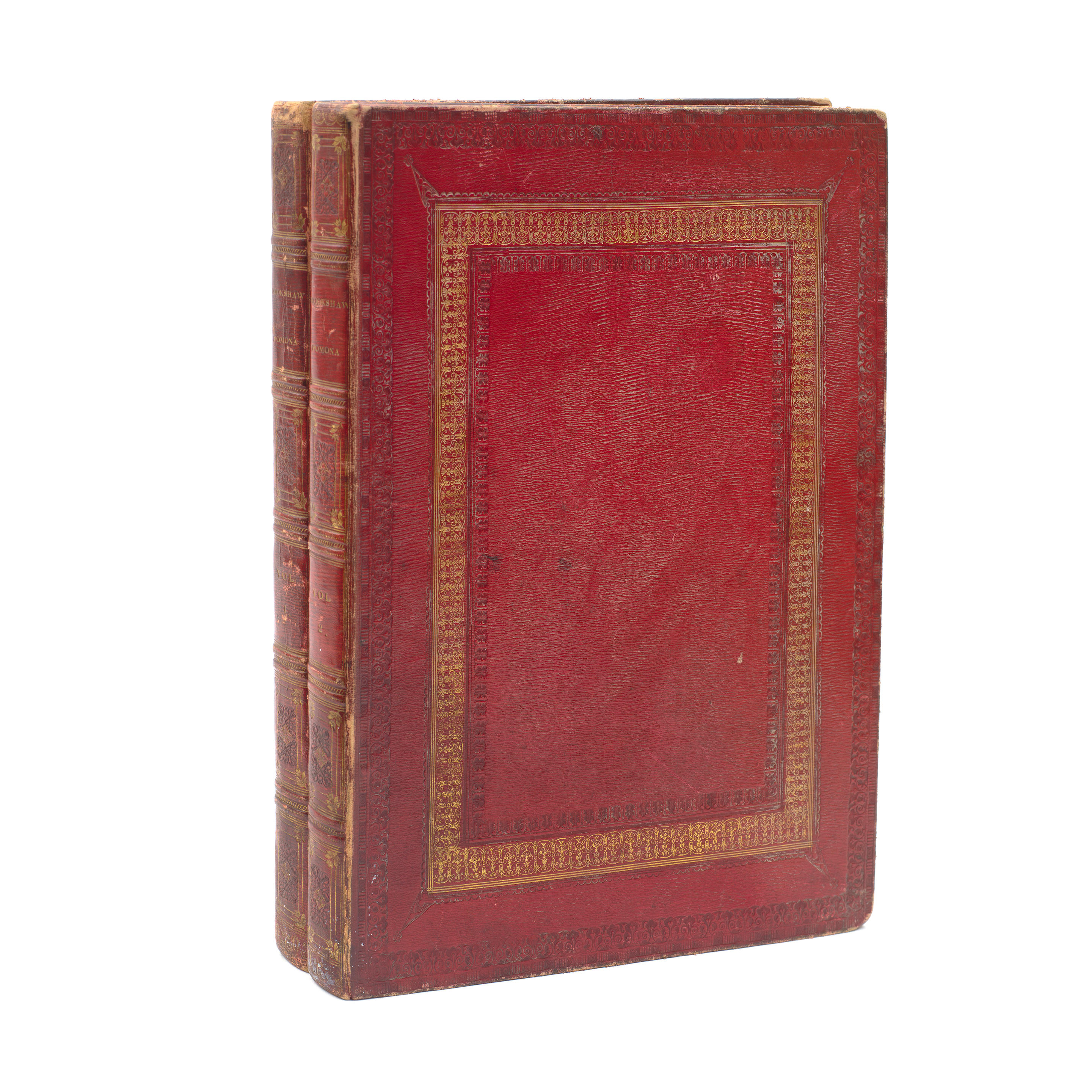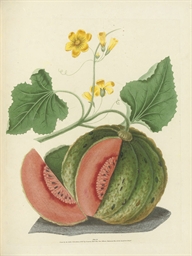BROOKSHAW, George (1751-1823). Pomona Britannica; or, a Collection of the most esteemed fruits at present cultivated in this country. London: T. Bensley for the author, published by White, Cochrane and Co., E. Lloyd and W. Lindsell, [1804-]1812. Large broadsheets (561 x 450 mm). 88 (of 90) AQUATINT AND STIPPLE-ENGRAVED PLATES AFTER G. BROOKSHAW, PRINTED IN COLOR AND FINISHED BY HAND numbered 1-93 (without plates 39, 42 and 46 as issued; plates 2, 4, 5 and 60 without the plate number or title; plates 19 and 20 bound after plate 23; plates 45, 64, 83 erroneously numbered 55, 65 and 80), with the author's printed slip explaining the absence of three pineapple plates, 1 page index. (Lacks plates 52 and 70, plate 65 supplied from another copy, ink stamp on verso, plates 3, and 90 loose and with chipping to edges, some minor marginal chipping to 9 plates.) Contemporary black morocco, tooled in blind and gilt (rebacked, old spine laid down, binding sprung, some wear to edges). Provenance : Massachusetts Horticultural Society, presented by Edgar F. Billings (bookplate, dated 1936). FIRST EDITION OF ONE OF THE FINEST COLOR PLATE BOOKS IN EXISTENCE, "surely the only fruit book to rival the showy quality of the flowers in Thornton's Temple of Flora " ( Oak Spring Pomona 40a, see also lot 124). Only plates 48 carries an engraver's name, that of H. Merke Nissen also credit's Richard Brookshaw The author's elder brother, was a mezzotint engraver who found popularity in France: his plates in the Pomona , dated 1804, are his last recorded works. The Pomona marked the re-emergence of George Brookshaw into the public eye after a total disappearance of nearly a decade. Until recently little had been known of Brookshaw's life, but in a recent article ("George Brookshaw: The case of the vanishing cabinet-maker", Apollo, May 1991) Lucy Wood has uncovered many details in the remarkable story of a man who began his career as a celebrated cabinet-maker and died a relatively unappreciated botanical artist - and seems to have deliberately obscured many of the connections between his two personae. Brookshaw, born in Birmingham and married to the daughter of a prosperous Birmingham gunsmith, moved to London in 1777 to embark on a career as a cabinet-maker. By 1783 he had attracted the patronage of the Prince of Wales and other prominent members of society; his furniture was noted for its all-over painted decoration with figurative, landscape and, above all, floral themes. An inscription on one of his bills presented to the Prince of Wales in 1783 describes him as a 'Peintre Ebiniste par Extraordinaire'. In spite of this success, no record survives of any furniture made by him after the mid-1790s. At this point, Lucy Wood suggests that a financial or sexual scandal drove him to live and work under a false name and precipitated his embarkation on an entirely new career. She believes that A New Treatise on Flower Painting , published anonymously in 1797 and later (in the third edition of 1799) in the name of G. Brown, was actually by Brookshaw, whose A Supplement to the Treatise on Flower Painting published in 1817 has largely the same content - including 11 plates supposedly by Brookshaw but identical to those in the earlier work, where they are attributed to Brown. Blanche Henrey (II, pp. 595-8), although not reaching the same conclusion, also draws attention to the similarity of the two works and the fact that Brookshaw makes no acknowledgement of Brown's work, as well as to the conspicuous lack of biographical details for either man. The Pomona was first issued in parts from 1804 to 1808 (apart from two plates dated 1812) and, if Wood's hypothesis is correct, is the first resumption by Brookshaw using his own name, as well as the first public indication of his new métier. The first edition of the complete work was published in 1812 and was dedicated to the Prince Regent, Brookshaw's most distinguished former patron. Many of the specimens were take
BROOKSHAW, George (1751-1823). Pomona Britannica; or, a Collection of the most esteemed fruits at present cultivated in this country. London: T. Bensley for the author, published by White, Cochrane and Co., E. Lloyd and W. Lindsell, [1804-]1812. Large broadsheets (561 x 450 mm). 88 (of 90) AQUATINT AND STIPPLE-ENGRAVED PLATES AFTER G. BROOKSHAW, PRINTED IN COLOR AND FINISHED BY HAND numbered 1-93 (without plates 39, 42 and 46 as issued; plates 2, 4, 5 and 60 without the plate number or title; plates 19 and 20 bound after plate 23; plates 45, 64, 83 erroneously numbered 55, 65 and 80), with the author's printed slip explaining the absence of three pineapple plates, 1 page index. (Lacks plates 52 and 70, plate 65 supplied from another copy, ink stamp on verso, plates 3, and 90 loose and with chipping to edges, some minor marginal chipping to 9 plates.) Contemporary black morocco, tooled in blind and gilt (rebacked, old spine laid down, binding sprung, some wear to edges). Provenance : Massachusetts Horticultural Society, presented by Edgar F. Billings (bookplate, dated 1936). FIRST EDITION OF ONE OF THE FINEST COLOR PLATE BOOKS IN EXISTENCE, "surely the only fruit book to rival the showy quality of the flowers in Thornton's Temple of Flora " ( Oak Spring Pomona 40a, see also lot 124). Only plates 48 carries an engraver's name, that of H. Merke Nissen also credit's Richard Brookshaw The author's elder brother, was a mezzotint engraver who found popularity in France: his plates in the Pomona , dated 1804, are his last recorded works. The Pomona marked the re-emergence of George Brookshaw into the public eye after a total disappearance of nearly a decade. Until recently little had been known of Brookshaw's life, but in a recent article ("George Brookshaw: The case of the vanishing cabinet-maker", Apollo, May 1991) Lucy Wood has uncovered many details in the remarkable story of a man who began his career as a celebrated cabinet-maker and died a relatively unappreciated botanical artist - and seems to have deliberately obscured many of the connections between his two personae. Brookshaw, born in Birmingham and married to the daughter of a prosperous Birmingham gunsmith, moved to London in 1777 to embark on a career as a cabinet-maker. By 1783 he had attracted the patronage of the Prince of Wales and other prominent members of society; his furniture was noted for its all-over painted decoration with figurative, landscape and, above all, floral themes. An inscription on one of his bills presented to the Prince of Wales in 1783 describes him as a 'Peintre Ebiniste par Extraordinaire'. In spite of this success, no record survives of any furniture made by him after the mid-1790s. At this point, Lucy Wood suggests that a financial or sexual scandal drove him to live and work under a false name and precipitated his embarkation on an entirely new career. She believes that A New Treatise on Flower Painting , published anonymously in 1797 and later (in the third edition of 1799) in the name of G. Brown, was actually by Brookshaw, whose A Supplement to the Treatise on Flower Painting published in 1817 has largely the same content - including 11 plates supposedly by Brookshaw but identical to those in the earlier work, where they are attributed to Brown. Blanche Henrey (II, pp. 595-8), although not reaching the same conclusion, also draws attention to the similarity of the two works and the fact that Brookshaw makes no acknowledgement of Brown's work, as well as to the conspicuous lack of biographical details for either man. The Pomona was first issued in parts from 1804 to 1808 (apart from two plates dated 1812) and, if Wood's hypothesis is correct, is the first resumption by Brookshaw using his own name, as well as the first public indication of his new métier. The first edition of the complete work was published in 1812 and was dedicated to the Prince Regent, Brookshaw's most distinguished former patron. Many of the specimens were take



.jpg)









.jpg)
Try LotSearch and its premium features for 7 days - without any costs!
Be notified automatically about new items in upcoming auctions.
Create an alert